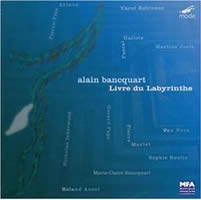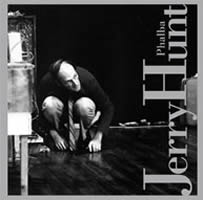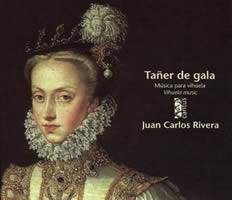From Other Worlds: Bancquart, Hunt, Schoenberg’s Handwriting, the Vihuela
|
Grant Chu Covell [September 2004.]
Alain BANCQUART: Le Livre du Labyrinthe (1995-2000): Prologue, Icare, Labyrinthe / Miroir, Solitude du Minotaure, Meurtre, Epilogue. Ensemble Vox Nova, Nicholas Isherwood (bass), Pierre-Yves Artaud (flute), Carol Robinson, Jérôme Voisin (clars.), Pascal Gallois (bassoon), Claude Pavy (elec. guit.), Roland Auzet (cymbalom), Emmanuel Curt, Thierry Briard (perc.), Virginie Tarète (harp), Martine Joste, Sylviane Billier, Brice Pauset (pianos), Pierre Morlet, Frédéric Baldassaré, Romain Garioud, Florian Lauridon, Michel Poulet (viola d’amores, cellos), Gerard Pape (sound eng.), Alain Bancquart (cond.). mode 120/21 (http://www.mode.com/). A trusted friend hands you a strangely colored gemstone. It seems to glow from within — a thing from another solar system. This is what mode’s release of Alain Bancquart’s Le Livre du Labyrinthe is like. There are musicians on this two-disc set I would follow anywhere: Pierre-Yves Artaud (flute), Carol Robinson (clarinet), Pascal Gallois (bassoon), Nicholas Isherwood (voice), Martine Joste (piano), and Gerard Pape (electronics). (Look ’em up in our search engine.) Bancquart’s gigantic six-part opus resonates with alien textures and aching lines. Suffused with intricately hewn microtonal music, each movement, scored differently, can stand alone as a unique work. This recording captures the integral premiere. Taken sequentially, each tableau seems the most remote outpost, the next unveiling something stranger still. Occasional passages throb with B-movie queasiness, yet the peculiar scales and tones make perfect sense. Bancquart isn’t some kid discovering how funky it is to play between the keys: He’s a master, effortlessly devising unbelievable sonorities. An instrumental Prologue sets the stage. Over an uneasy murk of two violas d’amore and one cello, clarinet and bassoon croon beseechingly like stranded whales. Arranged symmetrically in Le Livre du Labyrinthe’s grand scheme, two movements set Marie-Claire Bancquart’s poems: Icare for bass and five writhing cellos and Muertre, for vocal quartet and tape. Muertre clocks in at 34:11 as an ever-changing view. Constructed like a reluctant concerto, Labyrinthe / Miroir requires a solo piano tuned in quarter tones. Used sparingly, cymbalom and electric guitar circle in narrow tessituras. The subsequent Solitude du Minotaure demands two quarter-tone pianos and a third tuned in 16th tones. The pianos suggest bones rattling in catacombs. Muertre’s tape part offers eerily processed speech. A few spoken words spill into the clarinet and cello Epilogue, and finally we return to the light. But changed. You’ll be entranced and will return.
“Phalba.” Jerry HUNT: Phalba (Ila Multiplex) (1980?); Chimanzzi (Variant) (1987); Cantegral Segment No. 19 (1977); Chimanzzi (Olun) (1991). The Barton Workshop. Tzadik TZ 7093 (http://www.tzadik.com/). Other Barton Workshop forays (early Feldman on Etcetera KTC 3003 and a Wolff retrospective on mode 133/34) are mild compared to this. Here the Bartons, under James Fulkerson’s direction, animate four compositions by an oddball American, Jerry Hunt. Tzadik’s typically elegant production provides sparse notes. Trying to decipher the titles from the worklist at http://www.jerryhunt.org/JerryHunt/work.asp confuses even more. One piece not recorded here, Phalba (ILA) monopole: Kernel, bears the subtitle “action isolate using mechanical system construct-artifact array (Dee reversion variant).” Tzadik informs us that Texas-born Hunt started his own mail-order church in his 13th year. Academic studies occurred at North Texas State where he kept busy as a pianist, eventually moving into electronics, instrument building, audio and video. He was full of energy and conversation, and formed close artistic collaborations. He took his own life in a method he had diligently researched and documented. Phalba (Ila Multiplex) was written for James Fulkerson and Sarah Hopkins. Joyously compulsive and frenetic, a manic band warms up in a zoo: flute, trombone, violin, clarinet and “aural scores,” these unexplained. The instruments are amplified with a wide reverb. Malformed speech is barely audible, and keys or chains jangle throughout. The following Chimanzzi (Variant) couldn’t be more different. Scored for viola and piano without electronics or amplification, folksy melodic and harmonic fragments leisurely tumble past like a slow-moving chaconne. If it weren’t for the unrelenting intensity, it could pass for classic minimalism. Cantegral Segment No. 19, for trombone with live electronics and tape, illustrates Hunt’s obsessiveness. Electronics process and delay Fulkerson’s trombone, calling to mind what the love embrace of a vacuum cleaner and an outboard motor might sound like. Except for a bizarre, primitive-sounding percussion and tape section two-thirds of the way in, this 30-minute monochromatic spread is a walk on the beach at low tide. Chimanzzi (Olun), written for The Barton Workshop, calls for clarinet, violin, flute, cello and trombone. Similar to Phalba (Ila Multiplex), this bold chaotic block completes a winning disc.
Arnold SCHOENBERG: Friede auf Erden, Op. 13 (two vers: orig. a cappella, 1907; uncredited orch. arr., n.d.); Die Jakobsleiter (1917/22, unfinished). Salomé Kammer, Heidi Meier (sop.), Jonas Kaufmann, Stephan Rügamer, Kurt Azesberger (ten.), Dietrich Henschel, Michael Volle, James Johnson (bar.). Rundfunkchor Berlin, Deutsches Symphonie-Orchester Berlin, Kent Nagano (cond.). SACD format; play on a computer to follow along with Die Jakobsleiter’s autograph score. Harmonia Mundi HMC 801821 (http://www.harmoniamundi.com/). Schoenberg’s views on God always swung between intellectual logic and raw faith. Several religious works remain uncompleted: the opera Moses und Aron, several late psalm settings, and the oratorio Die Jakobsleiter. Begun in the pre-12-tone days, the oratorio packs a bruising, atonal punch similar to the earlier short operas Die Glückliche Hand and Erwartung. Schoenberg’s WWI service interrupted composition, and decades later, in America, he could no longer climb the rungs. A crucial addition to the Schoenberg discography, Nagano’s incisive reading of the unfinished Die Jakobsleiter thrills with its gravity and clarity. Winfried Zillig’s orchestration calls for a Mahler-size orchestra, although Schoenberg apparently imagined something lighter. Dietrich Henschel is a hefty yet questioning Gabriel. The well-prepared Rundfunkchor Berlin, directed by Simon Halsey, mediates between soloists and orchestra. Nagano confidently leads the whole ensemble. This is the recording to own. Two versions of Schoenberg’s Friede auf Erden frame Die Jakobsleiter: The first is an uncredited orchestral version, the twisting lines and thwarted tonal resolutions of which sound like a cross between Brahms and Ives. Whoever penned the transcription evidently studied Schoenberg’s Bach and Brahms orchestrations (Schoenberg himself?). Except for side-by-side German-English texts, Friede auf Erden receives zero booklet commentary. The a cappella choral original is fine, albeit anti-climactic, what with Die Jakobsleiter’s grittiness still ringing in one’s ears. The must-have clincher for musicologists and Schoenberg fans (oh yeah, they’re out there): Load this SACD into your computer and follow the autograph of Die Jakobsleiter’s short score while listening. It’s eerie how the music roars and snarls to seemingly naked notes. Schoenberg’s handwriting practically speaks for itself.
“Tañer de gala.” Various 16th-cent. composers including Luys MILÁN, Francesco CANOVA DA MILANO, Luys DE NARVÁEZ, et al. Juan Carlos Rivera (vihuela de mano). Cantus C9631 (http://www.cantus-records.com/). Distributed in the US by Qualiton (http://www.qualiton.com/). Before acquiring this disc, I thought a vihuela was a small dog. In Juan Carlos Rivera’s hands, this less familiar member of the guitar clan (distinct from the bowed vihuela) is capable of exceptional clarity and expression. Rivera can play! He unerringly balances melody and accompaniment with a dazzling intonation. While I have little context for this music (light dance pieces with pleasant melodies) or its age, my guess is that Rivera executes it perfectly. Others have praised Cantus’ engineering and Rivera sounds divine. There’s little of the characteristic sound of fingers sliding, an oddly beloved artifact for other guitarists. The 82-page trilingual booklet features many illustrations among José Carols Cabello’s well-detailed notes. Apparently, a three-toed sloth could count the number of extant vihuelas on one foot. It seems that many guitarists don’t know what a vihuela is. Compared to a lutenist’s potential library of 30,000 Renaissance pieces, the vihuela repertoire taps out at 800. I hope Rivera records more. This release showed up in my mail by accident. The distributor knows my new-music / modernist leanings. Perhaps a practical joke? In effect, not. This disc has enjoyed daily programming at home, where it’s affectionately referred to as the guitar CD. No, it’s not a guitar, but I don’t dare cultivate mispronunciations of vihuela. That’s Alonso Sánchez Coello’s portrait of Ana of Austria tartly beckoning on the cover.
[More Grant Chu Covell]
[Previous Article:
Random Noise 8: You Are an Audiophile]
[Next Article:
Sounds Like Now Festival in NYC]
|



